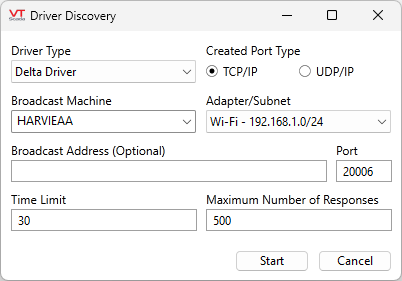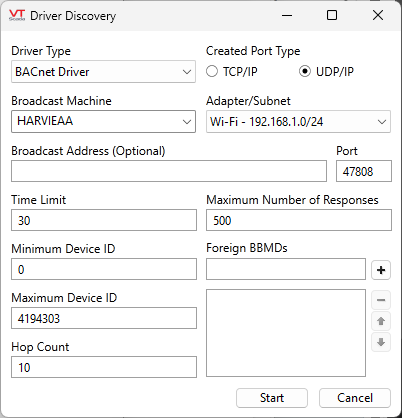Driver Discovery
Configure the Driver Discovery dialog according to the device and location you want to search. Details may vary according to driver type. After configuring, press the Start button to begin the discovery process. A progress dialog will be displayed while the process is underway.

This example shows driver discovery for the Delta Driver, which uses only the general settings.
Driver-specific settings for other driver types are described later in this topic.
Driver Type
Select the type of driver you wish to search for. Supported drivers include:
- BACnet Driver
- Delta Driver
(Applies only to Delta AH, AS and DVP PLCs )
Created Port Type
Used after discovery is complete and VTScada is about to create the port tags. Each driver will have their default choice (BACnet: UDP, Delta: TCP) but you can override that using this property.
Broadcast Machine
Should be set to the expected I/O Server
Adapter/Subnet
Select the internet adapter and corresponding IP Subnet to send the broadcast on.
Broadcast Address (Optional)
If not specified, VTScada will use the default broadcast address of the chosen subnet. (e.g 192.168.22.255) The broadcast address will also be the address from which the tool captures packets.
Port
Automatically set to the driver default.
Time Limit
The time to allow a discovery action to take place.
Maximum Number of Responses
Limit the number of responses that will be accepted.
If no driver information can be found on the specified Adapter/Subnet and port within the time limit allowed, the process will be aborted and an alert message displayed. Review the configuration to ensure the selected Broadcast Machine has communication with the remote devices.
Driver-Specific Configuration: BACnet

Minimum Device ID / Maximum Device ID (BACnet specific)
Allowable device IDs to respond to the Who-Is request. Typically left at the default range but can be set if only interested in locating a subset of BACnet devices.
Foreign BBMDs (BACnet specific)
Set the IP addresses of the BBMDs that will forward the Who-Is request to their foreign networks.
Hop Count (BACnet specific)
The number of times to forward the Who-Is request on the BACnet network. Typically done in a nested router situation.
